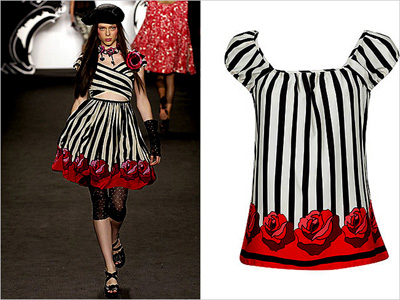Looking to the Past: Inspiration or Copying?
/Photo from www.nytimes.com
Last night the Cooper-Hewitt, National Design Museum held a panel discussion titled Groundbreaking: The Past as Inspiration, which was moderated by the Museum’s curator of contemporary design, Ellen Lupton. The panel consisted of fashion designer Anna Sui, textile designer Jessica Smith, and the architectural interior design team of Diamond + Baratta, each of whom, as Lupton described, used history to create their “imaginative, fantastic and irreverent” designs. All the designers acknowledged that their use of pattern was strongly influenced by historical examples, and that their appropriation consisted of contemporizing older patterns through distorting scale, changing colors, juxtaposing or collaging elements, or updating the subject matter. Most interestingly, the discussion rapidly turned to the question of design copying. Lupton noted that Sui was in the midst of a lawsuit against the chain Forever 21 for pirating her prints – in fact, last night Sui claimed that 26 of her patterns from her last season (which can be seen on the internet) had been copied by other designers or stores, including some copies which came out even before her designs were available for purchase! Diamond + Baratta, also victims of pirating, bemoaned the lack of legal protections available for design ideas. Jessica Smith openly admitted that she “borrowed from history” yet used patterns in a way that not only acknowledged their provenance, but stimulated conservation about the similarities to be found in historical cultures with society today. When pressed about the use of museums, archives and libraries for design inspiration, each of the designers agreed that there was a subtle difference between studying actual objects (usually for the perfection of craft, technique and construction) and blatantly ripping off photos of objects to create often-inferior copies. They noted that pencils were usually the only tools allowed when looking at historical objects, a restriction which creates an inherent gap between an original design and a drawing that is filtered through the designer’s talents and perception. Perhaps the most enlightening moment came when an audience participant asked whether the designers thought there was such a thing as completely original design at all. Diamond + Baratta mentioned Frank Gehry, but all agreed that there wasn’t a whole lot of design today that did not, in some aspect, reference historical works.
When I first started working in vintage fashion inspiration archives, I, perhaps naively, was shocked at the abundance of examples of blatant design copying. There were even instances when I found two garments, one the original and the other a copy, and it was only through noting the effects of age or examining the sewing and fabric that I was able to deduce which garment was, in fact, the “inspiration.” (Hint: the copy is inevitably the one poorly made from cheaper fabrics.) I understand the aforementioned designers’ frustrations with pirating, but I’ve come to the conclusion that all designers copy or reference to some extent. Even Anna Sui admitted last night that the pattern on the self-made dress she was wearing was derived from a swatch of vintage textile usually reserved for interior design purposes. In Sui’s mind, it was how she had manipulated the pattern for the human body (rather than a room) that made her design original. Isn’t claiming originality yet suing others for copying patterns that were very likely copies themselves a tad too contradictory? If everybody is doing it, is it really that bad? I think Lynn Yaeger put it best in her brilliantly funny article last year in the Village Voice when she claimed she would stop wearing cheap designer knock-offs just as soon as she had an extra few grand laying around to purchase the real thing.
Sarah Scaturro






